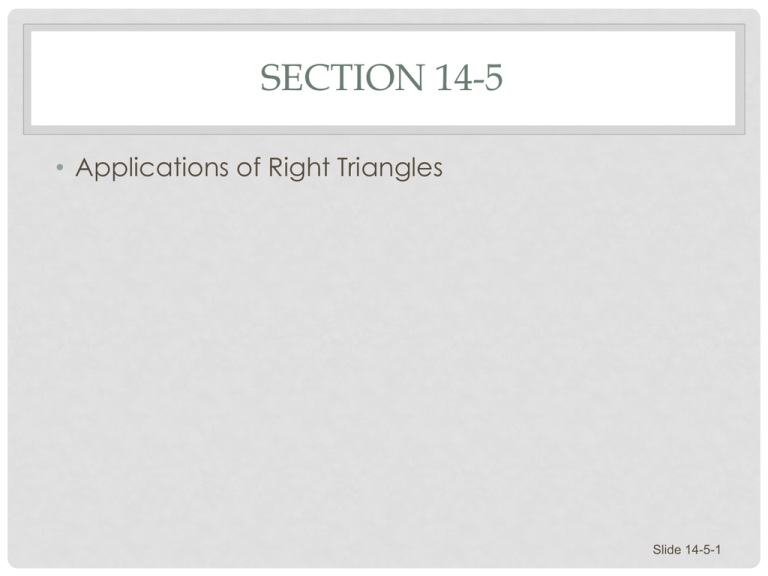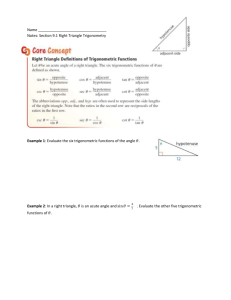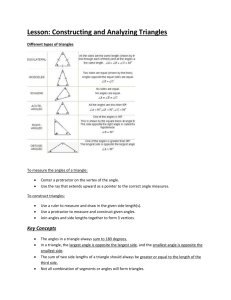solve a triangle
advertisement

SECTION 14-5 • Applications of Right Triangles Slide 14-5-1 APPLICATIONS OF RIGHT TRIANGLES • • • • • Calculator Approximations for Function Values Finding Angles Using Inverse Functions Significant Digits Solving Triangles Applications Slide 14-5-2 CALCULATOR APPROXIMATIONS FOR FUNCTION VALUES Because calculators differ among makes and models, students should always consult their owner’s manual for specific information concerning their use. When evaluating trigonometric functions of angles given in degrees, it is a common error to use the incorrect mode; remember that the calculator must be set in the degree (not radian) mode. Slide 14-5-3 EXAMPLE: FINDING FUNCTION VALUES WITH A CALCULATOR Use a calculator to approximate the value of each trigonometric function. a) sin 5412 b) sec32.662 c) tan( 321) Solution a) sin 5412 sin(54.20) .81106382 1 b) sec 32.662 1.18783341 cos 32.662 c) tan(321) .80978403 Slide 14-5-4 FINDING ANGLES USING INVERSE FUNCTIONS We have used a calculator to find trigonometric function values of angles. This process can be reversed using inverse functions. Inverse functions are denoted by using –1 as a superscript. For example, the inverse of f is denoted f –1. For now we restrict our attention to angles in the interval 0 90. The measure of an angle can be found from one of its trigonometric function values using inverse functions as show on the next slide. Slide 14-5-5 EXAMPLE: USING INVERSE FUNCTIONS TO FIND ANGLES Use a calculator to find a value for such that 0 90. and satisfies each of the following. a) sin .715332 b) sec 1.21112 Solution Use sin-1 (2nd and then sin). a) 45.6704 1 1 b) cos .8256820133 sec 1.21112 34.3423 Use cos-1. Slide 14-5-6 SIGNIFICANT DIGITS A significant digit is a digit obtained by actual measurement. A number that represents the result of counting, a a number that results from theoretical work and is not the result of measurement, is an exact number. Most values of trigonometric functions are approximations, and virtually all measurements are approximations. To perform calculations on such approximate numbers, follow the rules on the next slide. Slide 14-5-7 CALCULATION WITH SIGNIFICANT DIGITS For adding and subtracting, round the answer so that the last digit you keep is in the rightmost column in which all the numbers have significant digits. For multiplying or dividing, round the answer to the least number of significant digits found in any of the given numbers. For powers and roots, round the answer so that it has the same number of significant digits as the numbers whose power or root you are finding. Slide 14-5-8 SIGNIFICANT DIGITS FOR ANGLES Number of Significant Digits 2 3 4 5 Angle Measure to the Nearest: Degree Ten minutes, or nearest tenth of a degree Minute, or nearest hundredth of a degree Tenth of a minute, or nearest thousandth of a degree Slide 14-5-9 SOLVING TRIANGLES To solve a triangle means to find the measures of all the angles and all the sides of a triangle. In using trigonometry to solve triangles, a labeled sketch is useful. B c a C b A Slide 14-5-10 EXAMPLE: SOLVING A RIGHT TRIANGLE GIVEN AN ANGLE AND A SIDE Solve the triangle below. Solution a sin 40.3 14.8 a (sin 40.3)14.8 9.57 b cos 40.3 14.8 b (cos 40.3)14.8 11.3 B 14.8 a C 40.3 A b B = 90° – A = 90° – 40.3° = 49.7° Slide 14-5-11 EXAMPLE: SOLVING A RIGHT TRIANGLE GIVEN TWO SIDES Solve the triangle below. B Solution a 23.1 cos A 42.5 C A 57.1 42.5 23.1 A B = 90° – 57.1° = 32.9° a b c 2 2 2 a 23.1 42.5 a 35.7 2 2 2 Slide 14-5-12 APPLICATIONS The angle of elevation from point X to point Y (above X) is the acute angle formed by ray XY and a horizontal ray with endpoint at X. The angle of elevation is always measured from the horizontal. The angle of depression from point X to point Y (below X) is the acute angle formed by ray XY and a horizontal ray with endpoint at X. Y X Horizontal Angle of elevation X Horizontal Y Angle of depression Slide 14-5-13 EXAMPLE: ANGLE OF ELEVATION The length of the shadow of a building 35.28 meters tall is 40.45 meters. Find the angle of elevation of the sun. Solution 35.28 tan 40.45 41.09 35.28 m The angle of elevation of the sun is 41.09°. 40.45 m Slide 14-5-14






